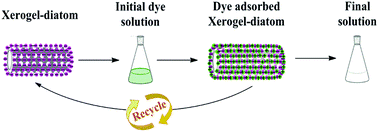Xerogel activated diatoms as an effective hybrid adsorbent for the efficient removal of malachite green†
Abstract
In the present work, naturally available, porous silica diatomaceous earth (DE) microparticles have been used for malachite green (MG) removal applications. To enhance the efficiency of the dye removal, the surface of DE was functionalized by different concentrations of silica-xerogel. The different concentrations of silica-xerogel on DE resulted in the formation of xerogel-diatom (XDE) materials, and these were named 1XDE, 3XDE and 5XDE. The specific surface area of the DE (30.2 m2 g−1) was greatly enriched after surface modification with 1XDE (94.7 m2 g−1), 3XDE (129.3 m2 g−1) and 5XDE (159.5 m2 g−1). MG dye removal studies were carried out using the 1XDE (91.73%), 3XDE (89.85%) and 5XDE (87.85%) hybrid materials, and they showed higher removal efficiencies compared to DE (61.64%). The mechanism of MG adsorption by the XDE adsorbents was studied and the adsorption process followed a Freundlich (R2 = 0.972) isotherm, which corresponds to multilayer adsorption. The rate of the MG adsorption behavior was studied and showed a greater correlation to a pseudo-second-order model (R2 = 0.999), that is, the rate of the adsorption process indicates chemisorption. A regeneration study was conducted using the hybrid adsorbents, and they were shown to have effective removal efficiency for up to five cycles. The dye removal studies showed that the XDE hybrid materials could be a potential candidate for use as a reusable wastewater treatment, for use in dye industries in particular.



 Please wait while we load your content...
Please wait while we load your content...